|
SB2078, was rebuilt (several
owners ago) by DSK in Jan 1980. I have the scuttle with the DSK
plate riveted on in my lap now as I speak. I'll take a picture
of it in a minute. (The scuttle, bonnet, nose etc are in the
house for safekeeping while the car gets a new wiring harness
and transmission tunnel out in the garage.
As far as DSK mods go it has
a chromed set of lower front end suspension arms. There might
be other things, but without comparing parts I wouldn't know.
When one of the two fuses started to blow in October, I decided
it was time to rewire. This car has a rear stabilizer bar. Probably
a DSK mod.
When the car gets put back together
I'll send some pics for your site. FYI, Its a 1965 S2 precrossflow.
It currently has a 120E block with the original 166e head, cam
and crank. (balanced of course)
Since I sent you the above information
David Kaplan has looked at pictures of my car and offered some
comments - most notably that the lower A arms are not his...
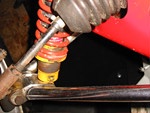 |
DSK: The chrome
a arms are not DSK Cars doing. Chrome plating risks damage from
hydrogen embrittlement and so we never chrome plated any structural
components. The original Lotus parts has a V configuration. We
added a thin tubular cross brace that turned the V into a true
A arm. |
| DSK: Most people
used our billet steering rack blocks as the stock Triumph Herald
castings were prone to catastrophic failure. This especially
on cars with wide wheels and tires, sticky rubber compounds and
other handling modifications. The
rack blocks are the first and most popular modification kit we
supplied. And that is a good thing. |
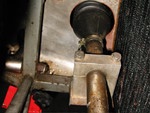 |
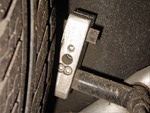 |
DSK: The rear sway
bar is probably ours. Stock Sevens had no rear anti-roll bars
installed. We designed and built kits to install larger front
bars and to add rear bars. So if 2078 has a rear bar, and the
car once passed through our shop, it is probably a DSK bar. |
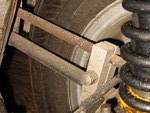 |
| The girdered Triumph
axle is typical. Not pretty but effective. Drilling out some
of the mass will pay nice dividends in ride quality, noise reduction,
shock and suspension bushing life and rough surface stability.
Stiffening the axle housing is a good idea, but making so heavy
is not. |
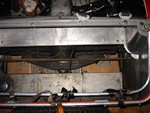 |
RV: The battery is on the left in front of the passenger footwell
(the Caterham position). This might have been done relatively
recently because there is still duct tape under the bonnet to
protect it from the terminals.
DSK: We routinely relocated the
batteries aft of the cockpit on the right side to improve weight
distribution. We mounted them on the left side of RHD cars and
on the right side of LHD Sevens. That helped further tweak the
balance when driving hard with only the driver aboard. A heavier
battery cable was required to maintain satisfactory cranking
power.
DSK: The Spax may well be of
our doing as well. Odds are good that if we changed them, we
also fitted our own springs. Stick Lotus springs were made of
cheap material and had many windings. They sagged and often made
noise as the coils rubbed together in bounce. We used "Stressproof"
steel and fewer coils. Our springs last forever, do not bind
and ride quietly and perform better. They are easy to stop because
of the reduced number of coils. The springs look like DSK springs.
The fronts and rears would be different. Using the same spring
rates front and rear is never a good idea.
DSK: The rust coming through
the chassis paint merits attention. If it's only happening in
a few spots, then you'll only need to touch them up. Try hard
to stay after them. If they appear to be the result of the paint
not sticking well to the chassis tubes after a the frame was
blasted and repainted, then you've got potential trouble. If
the paint between the steel chassis tubes and the aluminum skin
goes away, galvanic corrosion will eat the body away around the
rivets rather quickly. Inspect the chassis paint thoroughly,
please, and be certain that it is up to fine standard set by
the rest of your handsome Seven.
|